Surface Pro 8 vs. Dell XPS 13 2-in-1 (9315)
Microsoft's flagship 2-in-1 has some competition from the new XPS 13 2-in-1 (9315).
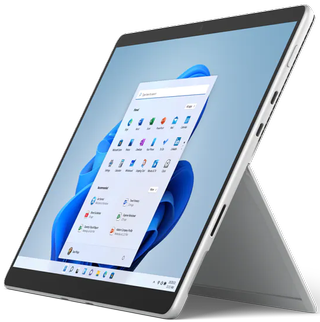
The Surface Pro 8 is the best Surface Pro that Microsoft has ever released. Its hardware might not be as up to date as the XPS 13 2-in-1, but it's still the right choice for many people as they await the launch of Dell's competitor.
For
- High-res touch display with 120Hz refresh rate
- Stand built into the tablet
- Impressive dual cameras
- More ports
- Readily available now
Against
- Still using 11th Gen Intel CPUs
- Pen and keyboard sold separately
- Only commercial versions have 4G LTE
- Glossy display finish
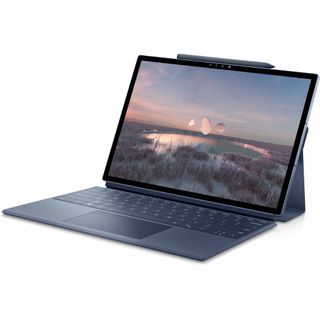
Dell's new XPS 13 2-in-1 (9315) has newer CPUs, optional 5G connectivity, anti-reflective display, and a design that's immediately familiar. It's set to launch Aug. 25.
For
- Thinner and lighter than the Pro 8
- 12th Gen Intel Core CPUs
- Optional 5G
- Beautiful touch display with AR finish
- Fingerprint reader and IR camera
Against
- Stand is built into the attachable keyboard
- Pen sold separately
- Fewer ports
- More expensive than the Pro 8
Tech specifications
Why you can trust Windows Central
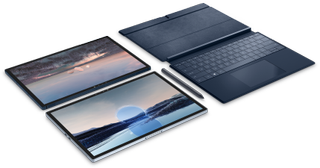
Dell's new XPS 13 2-in-1 (9315) is a return of the convertible 13-inch XPS, this time with a design much closer to the Surface Pro 8. Microsoft's 2-in-1 has long been one of our picks when it comes to the best Windows laptops, and it's expected that the new XPS 13 2-in-1 will fit into our collection of the best Dell laptops.
The new Dell 2-in-1 is expected to launch Aug. 25 with a starting price of about $1,099. Models with 5G connectivity are launching at a later date. U.S. and Canadian regions will get access first, with more regions expected to join in the coming weeks. On the other hand, the Surface Pro 8 has been available for some time now, with plenty of configurations available at the official Microsoft site and at third-party retailers.
Here's a breakdown of the specifications you'll find in each laptop.
| Header Cell - Column 0 | Microsoft Surface Pro 8 | Dell XPS 13 2-in-1 (9315) |
|---|---|---|
| OS | Windows 11 Home | Windows 11 Home, Windows 11 Pro |
| Processor | 11th Gen Intel Core i5-1135G7, i7-1185G7 | 12th Gen Intel Core i5-1230U, i7-1250U |
| RAM | 8GB, 16GB, 32GB LPDDR4x | 8GB, 16GB LPDDR4x |
| Graphics | Intel Iris Xe | Intel Iris Xe |
| Storage | 128GB, 256GB, 512GB, 1TB M.2 PCIe 3.0 SSD | 256GB, 512GB, 1TB M.2 PCIe 4.0 SSD |
| Display | 13 inches, 3:2 aspect ratio, touch, Dolby Vision | 13 inches, 3:2 aspect ratio, touch, Dolby Vision |
| Row 6 - Cell 0 | 2880x1920 (267 PPI), 120Hz refresh (60Hz default), 100% sRGB, 450 nits, glossy | 2880x1920 (267 PPI), 500 nits, HDR 400, 100% sRGB, anti-reflective |
| Pen | Sold separately | Sold separately |
| Ports | Two Thunderbolt 4, 3.5mm audio, Surface Connect | Two Thunderbolt 4 |
| Audio | Dual 2W stereo speakers, Dolby Atmos, dual far-field mics | Waves MaxxAudio Pro, Waves Nx 3D, dual mics |
| Wireless | Wi-Fi 6, Bluetooth 5.1 | Intel Killer Wi-Fi 6E, Bluetooth 5.2, 4G LTE, 5G |
| Camera | Front-facing 5MP (1080p), rear-facing 10MP (1080p), IR camera | Front-facing 1080p, rear-facing 11MP 4K, IR camera |
| Keyboard | Sold separately | Included |
| Security | TPM 2.0, IR camera | Fingerprint reader, IR camera |
| Battery | 50.2Wh | 49.5Wh |
| Dimensions | 11.3 x 8.2 x 0.37 inches | 11.5 x 7.9 x 0.29 inches |
| Row 16 - Cell 0 | (287mm x 208.3mm x 9.4mm) | (292.5mm x 201.2mm x 7.4mm) |
| Weight | 1.96 pounds (891g) | From 1.6 pounds (736g) |
| Color | Platinum, Graphite | Sky, Slate |
Design and features
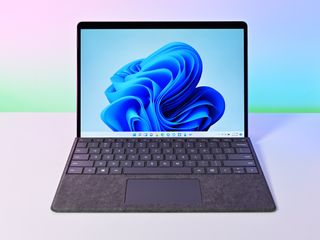
In his Surface Pro 8 review, Executive Editor Daniel Rubino states, "Nearly a decade on and Surface Pro 8, I'd argue, realizes that original idea of what this device could be." Compared to previous Pro models, the Pro 8 got an upgrade to an aluminum chassis with rounded edges for a more comfortable feel, a thinner display bezel for the larger screen, new speakers, a larger battery, and Thunderbolt 4 ports.
The Pro 8 now looks a lot like the Surface Pro X, and that's a good thing. Dell has attempted to mimic the Surface Pro lineup with its new XPS 13 2-in-1 (9315). The display is the same size, it has a similar keyboard that attaches magnetically, and it supports inking. The XPS 13 2-in-1 doesn't have the same built-in stand on the back, but its attachable keyboard folds back to keep the tablet upright. The upside here is that the XPS 13 2-in-1 weighs less and is thinner than the Pro 8 when used as a tablet.
Microsoft's tablet has two Thunderbolt 4 ports, Surface Connect, and a 3.5mm audio jack. Dell has shaved things down even further, offering just two Thunderbolt 4 ports. You'll still be able to connect to one of the best Thunderbolt 4 docks, but some might miss the headphone jack. To balance things out, the XPS 13 2-in-1 has optional 5G connectivity on top of Wi-Fi 6E and Bluetooth 5.2. The Surface Pro 8 can be had with 4G LTE, but only if you purchase from the commercial side of Microsoft's store.
We've yet to get our hands on the XPS 13 2-in-1, making it difficult to say how good the cameras and speakers really are. We do know that the Pro 8's cameras are both excellent. The front-facing 5MP (FHD) cam adds some AI support to track your face and adjust lighting, and the rear 8MP camera can do 4K video. The dual 2W speakers are also superb and come with Dolby Atmos for spatial audio. The XPS 13 2-in-1's cameras will likely rival those of the Pro 8. The front-facing camera is 1080p with IR and an ambient light sensor, while the rear camera is 11MP and shoots 4K.
Dell includes the keyboard with its XPS 13 2-in-1; Microsoft, in most cases, charges extra. The XPS Folio has 1.0mm key travel and a Precision touchpad, as well as providing a stand to keep the tablet upright. The Pro 8's Signature Keyboard also has a Precision touchpad and is available in a number of colors to match your style.
One more thing to watch out for is the upgradeable storage on the Pro 8. A small hatch on the back of the tablet gives access to the SSD, allowing you to upgrade in the future. The XPS 13 2-in-1 (9315) appears to be completely sealed up with no access for upgrades.
Display and inking
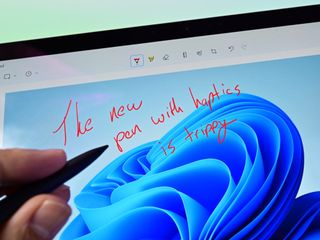
The Surface Pro 8's display blew us away when we first saw it, especially coming from the Pro 7. The latest generation moved to a larger 13-inch screen with thinner bezel and increased resolution, matching up the 267 pixels per inch (PPI) of the Pro 7. It still has a boxy 3:2 aspect ratio ideal for a tablet, color reproduction is excellent (100% sRGB), and brightness is decent at about 450 nits.
A new dynamic refresh rate can push it up to 120Hz from the native 60Hz, making inking feel even more natural. There's pretty much no latency, and new haptic feedback is available in some apps. The Pro 8 also introduced Dolby Vision to Surface lovers, providing enhanced video in supported content. There's also an adaptive color sensor that balances the tone of the screen to match ambient lighting.
Dell has a similar display in its XPS 13 2-in-1 (9315). It has the same 2880x1920 resolution, 3:2 aspect ratio, 100% sRGB color, and Dolby Vision. It also has HDR 400, up to 500 nits brightness, and an anti-reflective layer. That's a big bonus, as the Pro 8's glossy finish is certainly a standout flaw.
The XPS 13 2-in-1 is also capable of inking with the XPS Stylus. Like the Pro 8, you'll be buying the pen separately. We'll have more information on the XPS 13 2-in-1 (9315)'s display and inking experience when we get a model in for testing.
Performance and price
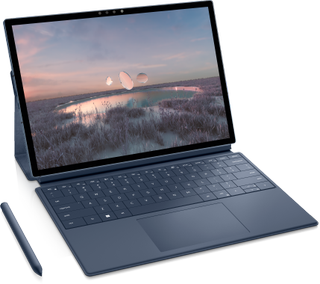
The Surface Pro 8 is equipped with Intel's 11th Gen Core i5-1135G7 and Core i7-1185G7 CPUs, with an extra Core i3-1115G4 option on the commercial side. Along with up to 32GB of LPDDR4x RAM and up to a 1TB SSD, it's an able performer if you're looking to handle productivity multitasking and even some light gaming. It's Intel Evo certified to ensure it delivers consistent performance on battery life as well as near-instant wake from sleep. Battery life is also excellent, with most tests reaching 10 hours or more on a charge depending on screen refresh rate and CPU inside.
The Dell XPS 13 2-in-1 (9315) is launching with 12th Gen Intel Core U-Series processors that should beat the Pro 8's performance capabilities. The new hybrid big.LITTLE architecture with Performance and Efficiency cores is just too good, and we've seen huge gains in other laptops we've recently reviewed. It's available with up to 16GB of LPDDR4x RAM and up to a 1TB M.2 PCIe 4.0 SSD.
We'll have a much closer performance comparison once we've put the XPS 13 2-in-1 through our laptop testing process.
The Surface Pro 8 is widely available now starting around $870. The XPS 13 2-in-1 (9315) is expected to launch Aug. 25 with prices starting at $1,099.
Get the Windows Central Newsletter
All the latest news, reviews, and guides for Windows and Xbox diehards.

Cale Hunt brings to Windows Central more than eight years of experience writing about laptops, PCs, accessories, games, and beyond. If it runs Windows or in some way complements the hardware, there’s a good chance he knows about it, has written about it, or is already busy testing it.